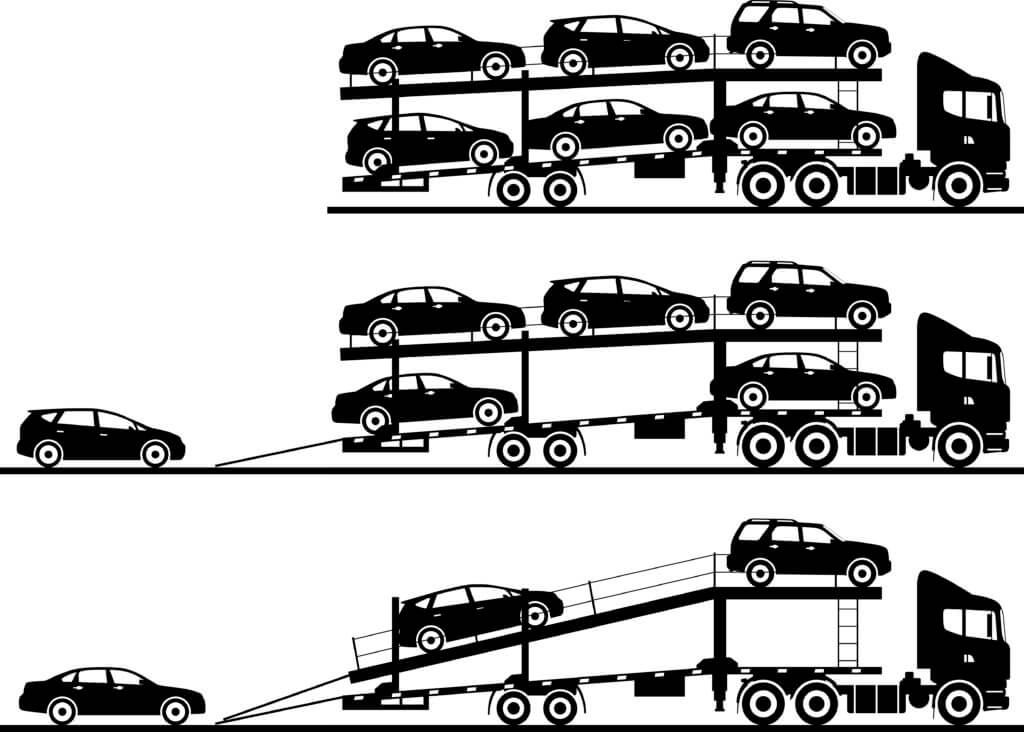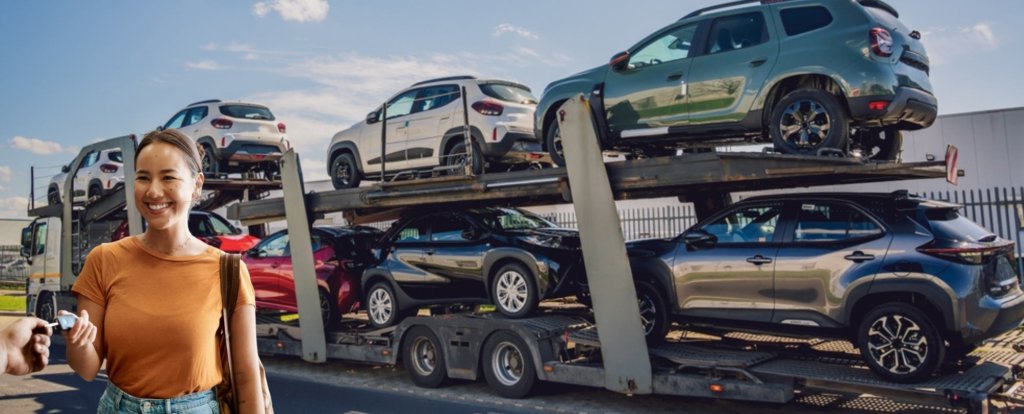Reading Time: 13 minutes Discover essential best practices for shipping your vehicle hassle-free. Learn how to ensure a smooth and secure journey for your prized automobile. The post Vehicle Shipping Tips | Secure and Affordable Solutions appeared first on...
Reading Time: 13 minutesCar shipping costs can be scary! Relax! Our vehicle shipping tips will calm you down quicker than a peaceful drive on a country road. Learn to manage costs and ask the right questions easily.
When itís time for an all-new adventure, moving places can seem daunting, especially when you need to haul your precious vehicle with you! Itís more than just a means of transport Ė itís a companion on the open road, a keeper of countless memories, and a substantial investment. Ensuring it reaches your new destination safely is absolutely crucial!
But hey, fear not! Youíre in the safe hands of your buddy here,! I am about to guide you through the maze of auto shipping with some handy-dandy Vehicle Shipping Tips! Letís chat all about choosing the right shipping method, preparing your vehicle for the big move, selecting a top-notch transport company, and comprehending that seemingly cryptic shipping agreement. Ready to accelerate towards a stress-free shipping experience? Buckle up, and letís get this show on the road!
Choosing the Right Shipping Method
Choosing the right shipping method might seem daunting at first glance Ė after all, your precious cargo means a lot to you! You might be eyeing that online tracking, eagerly anticipating your packageís safe arrival. Naturally, you want to ensure it gets to you in one piece and in record time. Understanding your shipping options can revolutionize your online shopping or business experience. That said, letís explore some shipping methods that youíve likely encountered.
Open Carrier Transport
First off, letís talk about Open Carrier Transport. These are the semi-truck trailers youíve probably seen on the freeway laden with cars, right? Hereís what you need to know about them:

Enclosed Carrier Transport
On the other hand, we have the Enclosed Carrier Transport. This is like giving your car a VIP ticket to its destination. Letís delve into its specifics:
As its name indicates, Enclosed Carrier Transport keeps your cargo enclosed and out of harmís way from external elements. Itís like giving your beloved vehicle its private suite, protecting it from weather conditions and road debris. Although it may be a tad pricier than Open Carrier Transport, youíll rest easy knowing your bundle of joy is taken care of and arriving in peak condition Ė worth every penny, right?Now that youíre armed with some fundamental knowledge about these shipping methods, you can make an informed decision tailored to your needs. Keep in mind the idiom Ďyou get what you pay forí. With shipping options, itís all about balancing cost, convenience, and the level of protection for your cherished cargo. Empower yourself in this process, because, after all, an informed consumer is a savvy consumer.
Preparing Your Vehicle for Shipping
Understanding the ropes of preparing your vehicle for shipping can feel like picking up a whole new skill. But donít fret; Iím here to guide you every step of the way, ensuring you avoid common pitfalls and keep your car protected. So, buckle up as we delve into everything you need to know!
Clean and Empty the Vehicle

First off, grab your washing kit and give your car a good scrub . Washing your vehicle does more than make it shinyófor shipping, itís a crucial step that can help reveal any existing chips, dings, or dents. You wouldnít want these to be overlooked in the inspection, would you?
. Washing your vehicle does more than make it shinyófor shipping, itís a crucial step that can help reveal any existing chips, dings, or dents. You wouldnít want these to be overlooked in the inspection, would you?
Next up- empty your car. Remove all personal items like loose change, sunglasses, or CDs from your glove box, side pockets, and back seats. Sorry folks, as much as your car shipping company would love to transport your favorite mixtape, theyíre not permitted to transport personal items. Plus, these objects can shift during transit and end up causing interior damage.
Inspect and Document the Condition
Before shipping, youíll want to take a close look at your caró and I mean really close. The aim here is to document your vehicleís condition pre-shipment, noting any scratches or dents.

Snap some photos from different angles, including close-ups of any damage. Most importantly, ensure that these pictures are time-stamped, or at least that you know their exact date of capture. In the unlikely event that your vehicle gets damaged during transport, these images will be your strongest evidence in an insurance claim.
Secure Loose Parts and Personal Belongings
If your car has any loose external parts ó like spoilers, fog lights, or side mirrorsó itís a good idea to secure them or even remove them. If they come off during transit, they could potentially cause damage.
Ensure you also remove personal belongings. For the most part, vehicle shipping companies carry insurance for the cars they transport, but this wonít cover your personal items.
Remove Toll Tags and Parking Passes
You wouldnít want to receive a bill for tolls your car passed while being transported, right? Therefore, before shipping, make sure you remove any toll tags or parking passes. Itís easy to forget this step, but itís a crucial one that could save you some unnecessary expenses.
With these steps, youíll be well-prepared for shipping your vehicle, providing it with the best possible protection during its journey. Safe travels to your car!

Tips to Choose the Right Vehicle Shipping Company
Thereís no denying that when the need arises to transport your caróbe it for a cross-country move, purchasing a car from a distance, or sending a car as a giftórelying on a professional auto transport company becomes a necessity. But with a myriad of options out there, how do you choose the right one for this significant task? Letís discuss some crucial factors you should take into consideration when making your decision.
Vehicle Shipping Tips | Check for Licensing and Insurance
First off, always make sure your chosen auto transport company carries the necessary licensing and insurance. This ensures that your car will be in good hands and adequately protected during its journey.
The auto transport company should possess an active U.S. Department of Transportation (USDOT) number. You can check this information online through the Federal Motor Carrier Safety AdministrationĎs website. Although it sounds like a bit of legwork, trust me, itís worth it.
Also, donít forget about insurance. Itís vital to understand what kind of coverage the company provides. If thereís a mishap (letís hope not!) during transit, you need to know that youíre fully covered.
Read Reviews and Gather Recommendations

Word of mouth still holds its weight when it comes to finding reliable services. Talk to friends, family, or colleagues who have used auto transport services before. Their recommendations can give you insights on which companies to consider and which ones to avoid. 
Online reviews are also goldmines of information. Look for ones that provide detailed experiences about the total cost, delivery punctuality, customer service, and condition of the vehicle upon delivery.
Tips for choosing the right vehicle shipping company | Get Multiple Quotes
Letís talk money. Costs can differ quite significantly from one company to another, so itís always a good idea to gather several quotes.
Keep in mind, though, the cheapest isnít always the best option. Consider factors like transit time, the method of shipment, and additional services offered when comparing quotes.
And that wraps up our little chat on selecting a reliable auto transport company. Remember to consider these three key aspects and donít rush the decision-making process. Itís about more than just getting your car from A to B; itís about ensuring it gets there safely, securely, and in the same gleaming condition it was when it left you.
Understanding the Shipping Agreement | Vehicle Shipping Costs
Shipping agreements can initially seem like a field of complex legal jargon, but donít worry, Iím here to help you make sense of the vital points. The agreement lays down the rules of engagement between shipper and carrier, and understanding its nuances is crucial when dispatching goods. Time to unpack the three main components: Terms and Conditions, Insurance Coverage, and the Pickup and Delivery Process.
Terms and Conditions
The terms and conditions are the cornerstone of the shipping agreement. Just like your favorite recipe, it includes all the essential ingredients that define the kind of relationship shipper and carrier will share. Here are some noteworthy features:

Donít just skim through the terms and conditions; instead, dedicate some quiet time to ensure you absorb every clause.
Vehicle Shipping Costs | Check Insurance Coverage
Next on our list is Insurance Coverage. Itís like your safety net, coming to your rescue if things go south. Insurance coverage is the carrierís promise to reimburse you for damage or loss of goods during transport, up to a certain amount. Key factors you need to zero-in on are:
Extent of coverage: Check what scenarios are covered (damage, theft, loss) and up to what amount. Claim process: Itís also essential to understand the claim process Ė what documents you need, time limit, etc.Remember, your peace of mind on shipment day largely depends on how well youíve understood the insurance coverage.
Pickup and Delivery Process
Vehicle shipping prices: The last cornerstone we will touch upon is the Pickup and Delivery Process. Here, youíll get clarity on stuff like:
Pickup points: The place(s) from where your goods will be collected. Delivery schedule: When and where your goods will be dropped off. Delays: How delays, if any, will be communicated and handled.Comprehending the entire pickup and delivery mechanism is pivotal to ensure fair vehicle shipping prices.
Whew, that made me break a bit of a sweat. However, with this information at your fingertips, youíre now equipped to confront any shipping agreement that comes your way. Remember, knowing these details can save you massive headaches down the line! Understanding the legalities might appear cumbersome initially, but consider it a stern handshake laying the foundation for a solid business relationship.
Tracking Your Vehicle During Auto Shipping | shipping my vehicle tips
Tracking your vehicle during auto shipping is a crucial aspect of ensuring a worry-free and smooth transportation process. Just like tracking an online purchase, monitoring the progress of your carís shipment offers peace of mind and allows you to be prepared for its arrival. Here are some vehicle shipping tips and strategies to help you track your car effectively:
Double-Check Your Delivery Information Accuracy is Key: Before you can track your vehicle, ensure that all shipping details provided by the carrier are accurate. This includes verifying pick-up and delivery addresses, and ensuring that all necessary documents, like the bill of lading and insurance forms, are complete and up-to-date??. Obtain a Tracking Number from the Carrier Stay Informed: Reach out to your shipping company or logistics provider to get a tracking number for your vehicle. This number is your gateway to real-time updates on your carís whereabouts. Visit the carrierís website or use their mobile app, input the tracking number, and youíll receive updates on estimated delivery times, locations, and any potential delays??. Utilize Third-Party Tracking Services Enhanced Tracking Experience: Donít limit yourself to just the carrierís updates. Third-party tracking services offer real-time updates and comprehensive tracking features. They provide the convenience of monitoring multiple carriers in one place. By inputting your tracking number into these services, you can get a fuller picture of your vehicleís shipping progress??. Communicate with the Carrier Open Communication is Vital: Maintain regular communication with the carrier throughout the shipping process. This is especially important for long shipments, like coast-to-coast moves. Regular updates, either from the carrier or third-party services, are crucial. Also, make sure to inform the carrier of any changes to your contact information to ensure seamless communication??.Vehicle Shipping Costs Considerations
Itís important to remember that while tracking your vehicle can be convenient, it may also be influenced by factors like weather, traffic, and scheduling conflicts. These factors can affect vehicle shipping costs and transit times. Being flexible and maintaining open communication with your shipping company will help you manage any unexpected changes during the shipping process.
By following these tips and being proactive in tracking your vehicleís shipping progress, you can enjoy a more controlled and satisfying auto shipping experience.
Receiving Your Vehicle | Shipping My Vehicle Tips
Well, folks, the day has finally arrived! After what felt like a lifetime of waiting, the keys to your dream vehicle are about to be yours. No doubt, youíre already imagining the feel of the leather steering wheel beneath your palms, the purring of the engine, and the envious stares from your neighbors.
Putting vehicle shipping prices aside. Remember, as exciting as this moment may be, itís crucial to follow specific steps when receiving your dream four-wheeler, or two-wheeler. Today, letís walk step by step through the process of inspecting the vehicle, documenting any damage, and settling your payment.
Inspect the Vehicle | car shipping tips
The appointment with your new rideís shiny exterior can be distractingóbut hold on! Before revving up the engine and zipping away, itís necessary to have a thorough inspection of the car. You want to doubt-validate every feature before feeling completely satisfied.
Test out all the lights ó headlights, tail lights, fog lights, and interior cabin lights. Donít forget the nitty-gritty details like wipers, door handles, and locks Listen carefully to any unusual noises, rattles, or squeals during a test drive.The inspection is not just about ensuring youíre getting what you paid for Ė vehicle shipping costs. Itís also about clearing any doubts in your head about the vehicle. So take all the time you need.
car shipping tips | Document Any Damage
Ok, you have checked out the goods and they seem fine. Still, it pays to be a bit more vigilant. If you spot any abnormalities, no matter how minute, remember to document them. Take a snap or shoot a video of the damage and ensure itís well recorded. A quick checklist for damage spots typically includes:
Paint job: look for blisters, mismatched colors, and overspray Dents and scratches: Check every panel for dents, big or small Tires: Keep an eye out for worn-out treads or damaged rimsYour documenting these can serve as a negotiation point, help you arrange for repairs, or even prevent disputes about vehicle shipping costs in the future.
Settling Payment
Once youíve checked and double-checked the vehicle, and satisfied with its condition, itís time to settle the vehicle shipping costs payment. As much as possible, try to make electronic payments. Itís safer and more traceable than cash. However you choose to pay, always make sure to get a receipt. If youíre paying in installments, remember to discuss and fully understand the payment plan.

Before the keys get handed to you, inspect the purchase agreement and every document related. You might be eager to bolt out of the showroom with your new vehicle, but itís worth spending a few extra minutes to ensure everything is in order.
Receiving your vehicle is a process that demands patient, careful, and meticulous attention to detail. But donít worryówith this guide, you have all the information you need to make sure it all goes smoothly. So slow down, take your time, and soon enough, youíll be hitting the road with your brand new ride.
Additional Vehicle Shipping Tips for a Smooth Experience
Ah, the love of the open road! Thereís something quite magical and liberating about taking to the highway on your own terms, with your favorite tunes playing and miles of possibilities ahead. However, ensuring a smooth experience involves a few steps more than just hopping into your car and setting off.
There are certain aspects and vehicle shipping costs to be considered, like notifying your insurance provider, removing custom accessories, and checking licensing and registration requirements.
Notify Your Insurance Provider
First things first, letís talk about how crucial it is to notify your insurance provider about your plans. Why, you ask? Well, insurance policies often vary depending on the carís location and use. Itís essential to ensure youíre covered thoroughly, regardless of where your adventures might lead you. One call or email to your insurance provider and voila! Suddenly, youíve avoided potential future complications. Plus, knowing youíre fully insured provides a sense of security Ė definitely a must for any long drive.
Vehicle Shipping Tips | Remove Custom Accessories
Next up, weíve got custom accessories. Now, we all love jazzing up our cars a bit, donít we? But, as heartbreaking as it sounds, itís safer to remove them before the journey. These could become a potential target for theft on the road. Also, more importantly, some accessories might even interfere with the vehicleís safety features or driving efficiency. So, prioritize vehicle shipping costs and safety over style for a bit, folks!
Check Licensing and Registration Requirements
Lastly, but certainly not least, consider the licensing and registration aspects. Each region can have its own vehicle shipping costs, rules and requirements. So it wouldnít hurt to do a little homework. Knowing what paperwork you need can save you unnecessary stress and potential fines further down the line.
So, friends, there you have it Ė a few additional tips to keep in mind for a smooth and joyful driving experience. Armed with this knowledge, youíre all set to conquer the open road. May your trip be filled with beautiful sights, lots of fun, and amazing memories.

Your Vehicle Shipping Tips with Nationwide Experts
Congratulations on reaching the end of our detailed guide on vehicle shipping tips. From preparing your vehicle to selecting the perfect transport method, youíre now well-versed in the essentials of seamless vehicle shipping and saving vehicle shipping costs.
Choosing the right partner is key to stress-free auto transportation. Nationwide Auto Transportation is dedicated to offering a smooth vehicle shipping experience across the U.S. Whether youíre moving cars, motorcycles, classic cars, or RVs, we ensure every vehicle is handled with the utmost care. Explore our car shipping services, discover the convenience of door-to-door auto transport, or check out specialized options like car buyers auto transport, motorcycle shipping, and classic cars auto transport.
Every vehicle shipping journey needs meticulous planning, attention to detail, and a trusted copilot. Start your journey with Nationwide Auto Transportation. Get a quote today and join the ranks of satisfied customers enjoying safe and efficient travels. 


Ready to ship your vehicle with confidence? Request a quote now and let Nationwide Auto Transportation guide you every step of the way!

For comprehensive insights on vehicle safety during transportation, refer to the National Highway Traffic Safety Administration resources.
Vehicle Shipping Tips | Frequently Asked Questions | Vehicle Shipping Costs
What are the best practices for shipping a vehicle?Some best practices for shipping a vehicle include: 1. Researching and selecting a reputable auto transport company, 2. Inspecting and documenting the condition of the vehicle before shipping, 3. Removing personal belongings from the vehicle, 4. Ensuring the vehicle is in working condition, and 5. Choosing the appropriate shipping method.
How do I select a reliable auto transport company?To select a reliable auto transport company, consider factors such as their reputation, customer reviews, licensing and insurance, experience in the industry, communication, and pricing. Itís also recommended to request quotes from multiple companies and compare their services before making a decision.
Should I get my vehicle inspected before shipping?Yes, it is advisable to have your vehicle inspected by a mechanic before shipping to identify any pre-existing damages. Taking detailed pictures or videos of your vehicleís condition can serve as evidence in case of any disputes or claims for damages during the shipping process.
Can I leave personal belongings in my vehicle during shipping?It is generally recommended to remove all personal belongings from your vehicle before shipping. Auto transport companies are not liable for any loss or damage to personal items left in the vehicle during transit. Itís best to double-check and remove all valuables and personal belongings prior to shipping.
What factors should I consider when choosing a shipping method for my vehicle?When choosing a shipping method for your vehicle, consider factors such as your budget, distance of the shipment, type of vehicle, and any specific requirements or preferences you may have. The two primary shipping methods are open transport (more affordable but exposes the vehicle to the elements) and enclosed transport (provides more protection but tends to be more expensive).
The post Vehicle Shipping Tips | Secure and Affordable Solutions appeared first on Nationwide's Blog - Nationwide Auto Transportation Blog.



